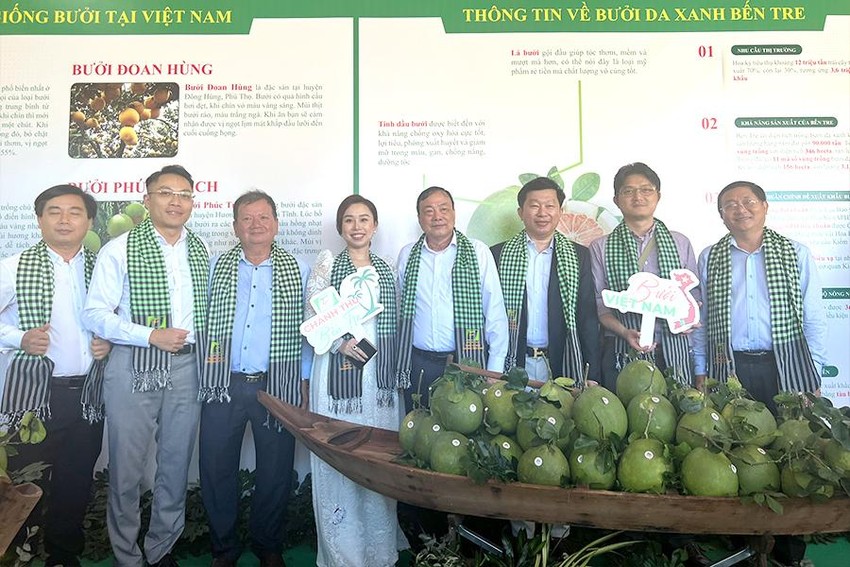Agricultures, Foods, News & Event
Good news for Vietnamese fruits and agricultural products
(PLO)- A series of agricultural products, especially Vietnamese fruits, have been officially imported by countries that have opened their markets.
“The year 2022 can be considered the most successful year ever with many plant-based agricultural products of Vietnam (VN) being allowed to access world markets.” That is the assessment of the Plant Protection Department under the Ministry of Agriculture and Rural Development when looking back at the negotiation process, opening the market for Vietnamese agricultural products to the “big sea”.
Grapefruit, lemon, durian, sweet potato… to the world
On November 28, the first batch of pomelos from Ben Tre started to leave for the US. This is the result of six-year negotiation efforts of the two sides’ specialized agencies and the persistent companionship of the Vietnamese pomelo producers and exporters. Thus, up to now, pomelo is the seventh fruit of Vietnam allowed to be imported into the US, after mango, longan, litchi, dragon fruit, rambutan and breast milk.

“The official export of the first batches of pomelos from Vietnam to the US is the joy not only of Ben Tre pomelo growers, but also the general joy of pomelo growers across the country. It helps businesses and farmers earn higher profits from this specialty fruit,” emphasized Deputy Minister of Agriculture and Rural Development Tran Thanh Nam.
But this is not the only and first joy of Vietnam’s fruit industry this year. First of all, passion fruit is officially imported into China (China) from July 1. After that, Vietnam’s durian and banana continued to be allowed to be officially imported into China through the signing of a protocol on phytosanitary requirements between the two countries. And recently, Vietnam and China continued to sign a protocol on plant quarantine requirements for Vietnamese sweet potatoes imported into China.
Not only the Chinese market, Vietnam’s lemons and grapefruits are also allowed to be imported into the New Zealand market after the import conditions were signed by the two sides on November 15. Most recently, on November 18, the Japanese side also announced to allow fresh Vietnamese longan to be imported into this fastidious market.
Towards a professional and methodical agriculture
Director of Plant Protection Department Hoang Trung said: The opening of the market and the signing of protocols for official export of agricultural products will create clear and transparent legal conditions and also create motivation for farmers. Vietnamese people produce professionally and methodically on a larger scale.
However, the director of the Plant Protection Department said that the above advantages can only be effectively promoted when the products fully meet the requirements of the importing country on plant quarantine and food safety and hygiene. Especially important is that the grown products must be traceable, from the management and supervision of the planting area to the input and output products; management of packing facilities, phytosanitary treatment measures up to the quarantine at the import border gate.
Mr. Hoang Trung, Director of Plant Protection Department, added that in the coming time, in order to promote and create motivation for the export of new products and complete market opening, the Ministry of Agriculture and Rural Development will organize events. export the first shipment of the above products.
“We will conduct training and guide for localities and stakeholders on the regulations of China, New Zealand, Japan … on import requirements for sweet potatoes, lemons, pomelos and longans” – Trung said.
Need to open more for many kinds of Vietnamese agricultural products
Mr. Dang Phuc Nguyen, General Secretary of the Vietnam Fruit and Vegetable Association, acknowledged that at the beginning of the year, fruit and vegetable exports were still facing many difficulties, because the largest market of the industry was China, which tightened the prevention of COVID-19 epidemic, leading to export turnover to this market decreased by 30%-35%. Although exports to other markets increased, it still could not make up for the decrease in volume from the Chinese market, which accounts for 50%-55% of export market share.
However, in the following months, when many kinds of fruits were opened to new markets, export growth of the fruit and vegetable industry recovered.
“For example, after Vietnam – China signed the protocol on durian export, up to now, the amount of durian exported to China has increased to more than 20,000 tons. This export volume of durian has contributed to the increase in fruit and vegetable export turnover in October and November,” said Nguyen.
Industry companies also said that after adding a new market, the price of some fruits, especially durian, has increased higher than before, making people and businesses very happy. Notably, Chinese consumers are very fond of Vietnamese durian, although the price is higher than that of Thailand, people still buy it all, not having enough goods to sell.
“However, with durian, we have only been granted 51 planting area codes and 25 packing facility codes from China. The number of codes issued is still small, so the amount of goods exported is not much. Meanwhile, with Thailand, the packing base code alone has been granted by China with nearly 600 codes. Therefore, we recommend that the Ministry of Agriculture and Rural Development continue to strengthen exchanges and negotiations with the Chinese side to be granted more export codes,” said a fruit export company.
Along with that, China has now opened the door to import more than 20 kinds of Thai agricultural products, while Vietnam has only 12 types. Therefore, the Vietnam Fruit and Vegetable Association and businesses have proposed to the competent authorities to continue negotiations so that the Chinese side and other countries can open more doors for more fruits and other agricultural products of Vietnam.
Source: https://plo.vn/tin-vui-don-dap-cho-trai-cay-nong-san-viet-nam-post710023.html
